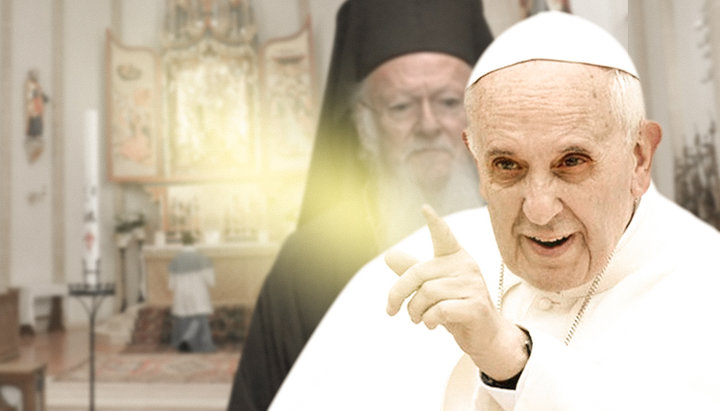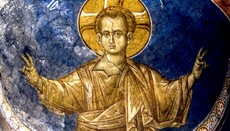“Anger” at God: different vision of prayer with Catholics and Orthodox

The ecumenism movement is gaining momentum. But God commanded us to stand in the Truth. Should we settle for falsehood in the name of imaginary unity?
In the context of modern trends in rapprochement and likely unification of the Orthodox and Catholics, the awareness of what distinguishes us is getting increasingly important. Both Patriarch Bartholomew and Pope Francis say that God commanded us to be in unity, which means we must strive for this unity despite whatever differences. But God also commanded us to stand in the Truth, which means that we should not agree to a lie, even in the name of imaginary unity. This article will focus on the difference between the Orthodox and Catholic understanding of prayer, which has become even more apparent after the recent discourse of the pope.

At the beginning of June 2020, at an audience in the Apostolic Palace, Pope Francis declared that there was no need to be afraid to enter into a dispute with God, and there was no need to be afraid ... to be angry with Him. Moreover, Pope Francis sees anger at God as a sign of our sonship with the Creator.
“This may seem like heresy, but often I hear from people that they are angry with God. ‘Dare you get angry with God?’ ‘Yes, I got angry’. But this is one form of prayer. Only a son can get angry with his father and then speak to him again. Let's learn from Abraham to pray with faith, to talk, to argue, but with constant readiness to accept the Word of God and to implement it in practice,” said the pontiff.
What is noteworthy in this statement?
“This may seem like heresy, but I often hear from people that they are angry with God. ‘Dare you get angry with God?’ ‘Yes, I got angry’. But this is another form of prayer.” Pope Francis
First of all, as strange as it may seem, but to be angry with God turned out normal for Catholics. The pope is the head of the Catholic Church and, accordingly, his circle of contacts includes mainly Catholics. Consequently, when he says that he often hears from people about their anger at God, it can be assumed that these people are the priesthood and believers of the RCC. It means that anger at God, according to the pope, may not be widely spread but still quite common practice in the spiritual life of Catholics.
Secondly, the pope claims that anger at God is one of the forms of prayer.
St. Theophan the Recluse, summing up the patristic experience, says: "Prayer is offering one’s mind and heart to God, praising and thanksgiving God, and asking Him for necessary blessings, both mental and physical." Can there be anger with God? Obviously, not. However, if we consider any communication with God as a prayer in general, then indeed we can find examples of such communication with anger. The very first and most striking example is Cain. He is the first to communicate with God with anger. “Then the Lord God said to Cain, ‘Where is your brother Abel?’ ‘I do not know,’ he replied. ‘Am I my brother's keeper?’" (Genesis 4: 9). What this anger led him to is well known: he became the first person to be damned.
Thirdly, when referring to the holy forefather Abraham in the context of disputes between God and man, Pope Francis apparently means a biblical episode when Abraham asked to have mercy on the cities of Sodom and Gomorrah and not to destroy them if there are righteous men there. Gradually, Abraham reduced this number of the righteous from 50 to 10, and God agreed to it every time. But can this be called a dispute, a discussion? Obviously, not. Any dispute presupposes the existence of a subject of the dispute, i.e. different views which disputants may have. In the case of Abraham, this is not the same as in the case of the Prophet Moses, who interceded for the sinned Israelites, or the Apostle Paul, who would have excommunicated from Christ himself, if only his fellow brothers Jews could believe and be saved. All these people asked God for mercy, which He wants to pour abundantly on people, if only people would be able to embrace this mercy.
What Pope Francis said about prayer borders on sacrilege for the Orthodox consciousness (or even does not border on it). But these words are a consequence of the doctrine of prayer, which has developed in Catholicism over the centuries, and which from the point of view of the Orthodox experience is nothing but a detrimental delusion.
Holy Fathers about delusion
Saint Ignatius Brianchaninov writes: “The most dangerous and wrong way of prayer is when a praying person, by the power of his imagination, his fantasies and pictures, borrowed apparently from the Holy Scriptures, but in effect from his own mind, from his fallen nature, from his sinfulness, from his self-deception, plays up to his conceit, his vanity, his arrogance, his pride and deceives himself. Obviously, everything that comes out of mystical propensities of our perverted fallen nature does not really exist – it is delusion and falsehood being so natural and so sweet for the fallen angel.”
Early holy fathers give the same interpretation of prayer.
“Do not indulge in fantasies on your own and if visions emerge on their own, do not heed those and do not allow your mind to be stamped with them. For all this, being impressing and fanciful, serves to seduce the soul. The mind in itself has the natural power to dream and can easily create illusive images of what it longs for ... Then the one experiencing this is already a dreamer not a silence-keeper” (St. Gregory of Sinai, XIII century).
“Do not be willing to see angels, or dominion, or Christ sensually, so as not to go insane, mistaking a wolf for a shepherd and bowing to hostile demons ... If you want to pray in the spirit, do not borrow anything from your flesh” (St. Nile of Sinai, V century).
Sensuality in Catholic prayer
In Catholicism, it is precisely this work of imagination that is recommended for prayer. The Catholic prayer teacher Ignatius Loyola (XV c.) writes: “A conversation takes place when a person imagines before himself Jesus Christ crucified on the cross. At a time when this striking image appears in front of a person’s eyes, he begins to ask himself, to ponder, to weigh what exactly made the Creator become human and take the form of a creature and a slave. <...> Having thus fixed our gaze on Jesus crucified, I will tell Him everything that my mind and my heart will tell me ... A real conversation can be compared to a conversation between two friends or a conversation between a servant and his master.”
This visionary thinking brought Catholic "saints" to the states that cannot be defined otherwise than delusion.
The biography of Margarita Maria Alakokviyskaya says that she had a vision of the heart of Christ, “surrounded by rays of a more dazzling brilliance than the sun, and transparent like crystal. It clearly showed the wound He had received on the cross. There was a crown of thorns around His divine heart, and a cross above it.” Embracing this vision, Margarita Maria in her later life often fainted and felt ecstatic and became incapable of routine monastic life.
The “holy” Gertrude (13th century), a nun of the Benedictine order, was honored, to put it mildly, with unique kisses. “Once during a prayer in the chapel she heard the singing: ‘Sanctus, sanctus, sanctus!’ The Son of God bent over her like the most tender lover and imprinting a sweet kiss on her soul, said to her at the second Sanctus: ‘With this Sanctus glorifying Me, accept in My kiss all the sanctity of My Divinity and My humanity, and this will prepare you to receive the Holy Mysteries.’ And when next Sunday she thanked God for this mercy, the Son of God, more beautiful than thousands of angels, took her in his arms and, as if proud of her, presented her to God the Father in the perfection of holiness He had bestowed on her,” her biography says.
From the biography of the Catholic Saint Gertrude: “The Son of God bent over her like the most tender lover and imprinting a sweet kiss on her soul, said to her at the second Sanctus: ‘With this Sanctus glorifying Me, accept in My kiss all the sanctity of My Divinity and My humanity, and this will prepare you to receive the Holy Mysteries’.”
Francis of Assisi (XII century) in his prayer exercises went so far as to see himself equal to God: “Two great lights appeared before me. In one of them I recognized the Creator, and in the other I recognized myself” and soon “I felt completely transformed into Jesus (il se sentit change tout a fait ep Jesus).” The wounds on his arms, legs and abdomen emerged on his body, which were subsequently called stigmata.
On the contrary, the more Orthodox saints approached perfection in prayer and life, the more they were aware of their sinfulness and unworthiness. Repentance is the only thing true prayer can be based on.
“All kinds of demonic charms, which an ascetic of prayer is subjected to, arise from the fact that prayer is not rooted in repentance, that repentance has not become the source, soul, purpose of prayer” (St. Ignatius Brianchaninov).
“No matter how lofty our exploits could be, if we do not acquire a painful heart, then these exploits are both false and futile” (St. John Climacus).
“The first sign of the recovering soul is vision of its countless sins as if it were the sand of the sea” (Ven. Peter of Damascus).
***
Thus, in addition to the doctrinal discrepancies between Orthodoxy and Catholicism, there are also mystical discrepancies, which also constitute a barrier to the desired “approximation”. Whoever has fallen into a state of delusion requires healing from this state instead of recognizing it as the truth. Isn’t it possible to imagine that Catholics will abandon this thousand-year-old error in terms of prayer and accept the only correct teaching about it, which is laid in the creations of the holy fathers? Of course, everything is possible with God, but the last statements of Pope Francis about prayer indicate that Catholics are not on the path of healing, but rather on the path of exacerbation of this detrimental state of theirs. Therefore, the Orthodox, before they agree to any rapprochement with the Catholics, must ask themselves a question: are we both going in the same direction?











